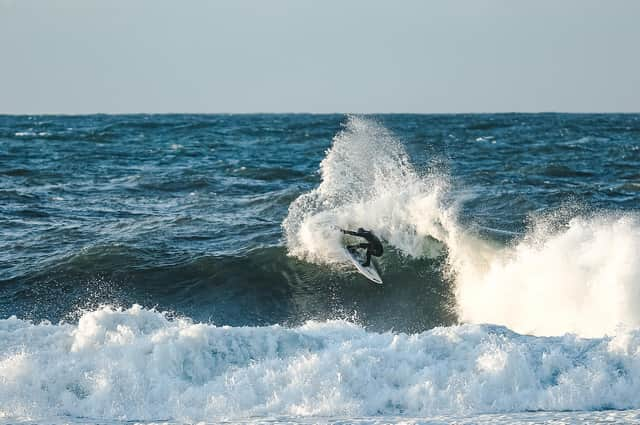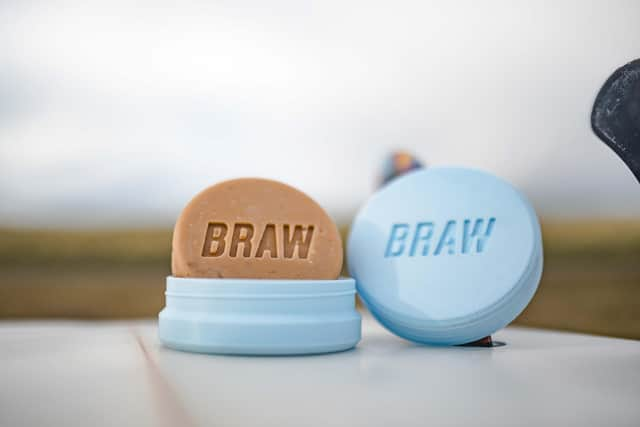Braw: The Scottish company on a mission to make sustainable surf wax


“We’ll all be planning that route / We’re gonna take real soon / We’re waxing down our surfboards / We can’t wait for June / We’ll all be gone for the summer / We’re on surfari to stay / Tell the teacher we’re surfin’ / Surfin’ USA.”
Thanks to the second verse of the Beach Boys’ 1963 classic Surfin’ USA, the concept of waxing a surfboard is now familiar to millions of non-surfers all around the globe. The question of what exactly this process entails, however, doesn’t seem to be quite so universally understood. Perhaps because skiers wax the bottoms of their skis in order to make them go faster, a lot of people mistakenly assume it’s the same deal with surfing. (No shame if that was you by the way: the long-time Hawaii resident Paul Theroux just published his first surfing novel, Under the Wave at Waimea, and even he and his editors seem to be under the impression that the purpose of surf wax is to make boards go faster.)
Advertisement
Hide AdAdvertisement
Hide AdSo, just to make sure we’re all on the same page: surfers rub wax onto the top of their boards (known as the deck) to give them grip in the water. Without wax, the surface of a surfboard would be about as slippery as an ice rink, and the sport of surfing would be the eighth slapstick wonder of the world. You can spend hundreds of pounds on a surfboard, but without a little bar of wax costing a couple of quid, you’ll get nowhere.
For decades, the surf wax market has been dominated by a few big brands, most of which delight in riffing on the onanistic undertones of wax application on their packaging. Made in California since 1972, Mr Zogg’s Sex Wax claims to be "the best for your stick" while Mrs Palmers, made in Australia, encourages users to "Give it a rub – the feeling just keeps getting better." These traditional waxes tend to be made from either paraffin wax or soy wax, neither of which are renewable resources and both of which involve the use of petrochemicals in their manufacture. However, there are renewable alternatives, and a new Scottish company called Braw is looking to capitalise on this gap in the market while also sidestepping the dubious Carry On vibes.
Braw was founded in January 2020 by three surfers who met at Napier University and realised they had complimentary skills: Donald Inglis, Tonie Nguyen and Oscar James. Inglis studied business and marketing at Napier; Nguyen is a designer, originally from Germany, who moved to Scotland to study and stayed on afterwards to work on Braw; and James’s background is in sports media, mainly photography and video work – we have him to thank for the slick video footage of this year’s British Surfing Championships, held at Thurso East.
“We all met through the surf club at university,” says James. “We went on a holiday together to Spain – I think that was in the summer of 2019 – and we all got into surfing at around the same time.
“The business idea only came about last year,” he continues. “Duncan had lived in South Africa, and while he was there somebody taught him a recipe for organic surf wax. Surfing in Scotland is still a niche thing, and a lot of the surf waxes you buy don’t really work here, even the cold water ones – when they get really cold they just get super hard and then you can’t get them onto your board. It’s just one of these things that everybody accepts about surfing in Scotland, but we thought we’d try and do better."


So, Braw’s goal is to make a wax that works in cold water and is also sustainable. In order to achieve this, a lot of painstaking research and development was required, and ultimately this meant finding some willing product testers, waxing up their boards with the latest prototypes and then sending them out into the North Sea. A video on the Braw website shows how much work goes into a test day, not just for the surfers trialling the different waxes – in this case Simon Olsson and Hugo Spinola – but also for the crew back on the beach, who have de-wax and then re-wax boards in between surfs and also keep meticulous notes on what worked and what didn’t.
“That day we had nine or ten variations,” says James. “It’s pretty hard on the boys – they surf for a bit, come out of the water, grab their other boards that we’ve already waxed up and then go straight back in. That day they were surfing for about four hours.”
After trialling “between 50 and 60 variations” the Braw crew have just launched a product they believe is a winner: their all-new Celtic wax. Without giving away the secret recipe, James is able to tell me that it includes bees’ wax, either coconut oil or rape seed oil, depending on availability, and pine resin. "It’s all done by hand," he says. "All we need is a gas hob and we can make it pretty much anywhere. It’s not like we’re going to become a mass operation – we just wanted to see if it was possible to make it and if people would want to buy it, and so far it’s going pretty well."
For more on Braw, visit www.brawsurf.co.uk
A message from the Editor:
Advertisement
Hide AdAdvertisement
Hide AdThank you for reading this article. We're more reliant on your support than ever as the shift in consumer habits brought about by coronavirus impacts our advertisers.
If you haven't already, please consider supporting our trusted, fact-checked journalism by taking out a digital subscription at https://www.scotsman.com/subscriptions